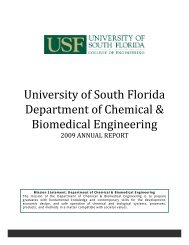2010 - Chemical & Biomedical Engineering - University of South ...
2010 - Chemical & Biomedical Engineering - University of South ...
2010 - Chemical & Biomedical Engineering - University of South ...
Create successful ePaper yourself
Turn your PDF publications into a flip-book with our unique Google optimized e-Paper software.
Technological solutions have<br />
to be developed that are<br />
efficient, environment<br />
friendly, and can be<br />
economically implemented<br />
in large-scale processes.<br />
Dr.Vinay Gupta’s research group<br />
left to right:<br />
Bijith Mankidy,<br />
Chhavi Manocha,<br />
Cecil Countino,<br />
Kristina Tran,<br />
Dr. Gupta,<br />
Rashima Harrinauth,<br />
Fedena Fanord and<br />
Alisha Peterson.<br />
Dr. Gupta - <strong>Engineering</strong> Novel Hybrid and<br />
Composite Materials<br />
Removal <strong>of</strong> chemical contaminants<br />
in aqueous streams is a critical challenge<br />
faced by society. Technological solutions<br />
have to be developed that are efficient,<br />
environment friendly, and can be economically<br />
implemented in large-scale<br />
processes. Nanoparticles <strong>of</strong> metals and<br />
mineral oxides have made it possible to<br />
design and develop improved substrates<br />
for efficient removal <strong>of</strong> organic and inorganic<br />
contamination, either by sorption<br />
or sequestration mechanisms, or as<br />
a catalyst. The high surface area to volume<br />
ratio due to nanometer size <strong>of</strong> the<br />
particles and the accompanying physical<br />
and chemical enhancement <strong>of</strong> surface<br />
properties is one <strong>of</strong> the key factors behind<br />
the efficiency in remediation. A<br />
major bottleneck in the use <strong>of</strong> nanoparticles<br />
is that the size <strong>of</strong> the particle affects<br />
the remediation technology. For<br />
example, in fixed bed reactors the packing<br />
material must not easily clog; similarly<br />
for treatments that use fine<br />
particles in a batch type reactor, a filtration<br />
system is needed to recover the<br />
particles from the liquid effluent. The<br />
nanoparticles, while advantageous for<br />
organic decontamination, rapidly become<br />
an expensive liability due to increased<br />
process complexity, need for<br />
critical process control, and an increased<br />
potential for environmental pollution as<br />
well as cost <strong>of</strong> chemicals due to incomplete<br />
or inefficient recovery <strong>of</strong> the<br />
nanoparticles. Strategies such as coatings<br />
<strong>of</strong> nanoparticles on walls, plates, or<br />
beads are <strong>of</strong> limited use as they reduce<br />
surface availability <strong>of</strong> the particles and<br />
pose limitations on transporting contaminants<br />
to the particle surface. Challenges<br />
such as these are being<br />
addressed at the <strong>University</strong> <strong>of</strong> <strong>South</strong><br />
Florida in the research program led by<br />
Dr. Vinay Gupta. The focus is on engineering<br />
novel materials and constructs<br />
by combining polymers with metallic or<br />
oxide nanoparticles using interfacial<br />
modifications and assimilating the<br />
unique properties <strong>of</strong> each component.<br />
To eliminate the bottleneck in using<br />
nano-sized photocatalyst for the remediation<br />
<strong>of</strong> contaminated waters, Gupta’s<br />
research has established a novel and<br />
unique approach where transparent,<br />
cross-linked, porous polymer microspheres<br />
are impregnated with photocatalytic<br />
titanium dioxide (or titatnia)<br />
nanoparticles. Using a simple and easy<br />
mixing technique allows for the preparation<br />
<strong>of</strong> the microcomposites in an economically<br />
feasible manner and allows the<br />
loading <strong>of</strong> titatnia to be controlled (J.<br />
Colloid & Interface Science, 116-122,<br />
2007; patent pending). These microcomposites<br />
show rapid sedimentation in minutes,<br />
which is useful for gravity<br />
separation <strong>of</strong> these particles in applications<br />
such as remediation. The photograph<br />
(right) illustrates photodegradation<br />
<strong>of</strong> a model contaminant, an organic<br />
dye, using both the microcomposites and<br />
the free titatnia nanoparticles. The photodegradation<br />
is achieved using a commonly<br />
available BLB light bulb that<br />
simulates light in the UVA range (~365 nm),<br />
which is readily available in sunlight. After<br />
the degradation <strong>of</strong> the dye into carbon<br />
dioxide and water, the free titatnia<br />
nanoparticles remain suspended in the<br />
water but the microcomposites settle rapidly,<br />
which makes them suitable for use in<br />
large-scale clarifiers and sedimentation<br />
tanks. In addition to the practical applications,<br />
Gupta’s research group has also fundamentally<br />
studied the settling behavior <strong>of</strong><br />
these microgel-titatnia composites as these<br />
permeable particles provide an interesting<br />
contrast to the sedimentation <strong>of</strong> solid, impenetrable<br />
spheres (Colloids & Surface A,<br />
111-121, 2008). These particles provide a<br />
suitable experimental system to gain insights<br />
into sedimentation behavior <strong>of</strong> complex<br />
systems such as permeable particles<br />
and flocs <strong>of</strong> fine particles held by organic<br />
matter that are <strong>of</strong> practical significance in<br />
diverse areas such as marine geology,<br />
coastal and ocean science, hydraulic engineering,<br />
and solid-liquid separation technology.<br />
p3





